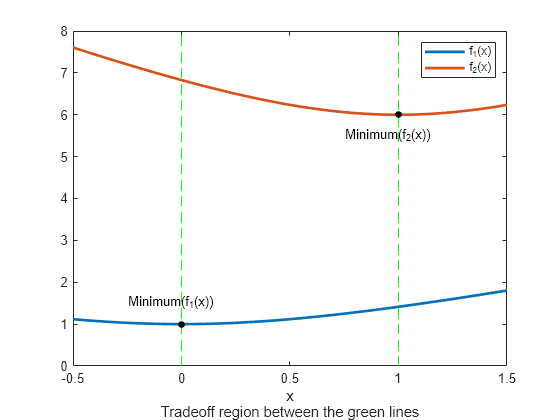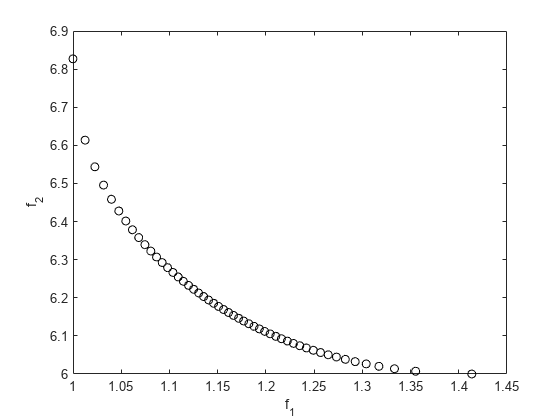生成并绘制帕累托前沿
此示例说明如何使用 fgoalattain 为二维多目标函数生成和绘制帕累托前沿。
此示例中的两个目标函数是凸函数 经平移和缩放的版本。目标函数的代码出现在此示例末尾的 simple_mult 辅助函数中。
这两个目标函数都在区域 中递减,在区域 中递增。在 0 和 1 之间, 递增, 递减,因此存在权衡区域。绘制 的两个目标函数,范围从 到 。
t = linspace(-1/2,3/2); F = simple_mult(t); plot(t,F,'LineWidth',2) hold on plot([0,0],[0,8],'g--'); plot([1,1],[0,8],'g--'); plot([0,1],[1,6],'k.','MarkerSize',15); text(-0.25,1.5,'Minimum(f_1(x))') text(.75,5.5,'Minimum(f_2(x))') hold off legend('f_1(x)','f_2(x)') xlabel({'x';'Tradeoff region between the green lines'})

要找到帕累托前沿,首先要找到两个目标函数的无约束最小值。在本例中,您可以从图中看到 的最小值为 1, 的最小值为 6,但通常您可能需要使用优化例程来找到最小值。
通常,您可以编写一个返回多目标函数特定分量的函数。(此示例末尾的 pickindex 辅助函数返回第 个目标函数值。)然后使用优化求解器找到每个分量的最小值。在本例中您可以使用 fminbnd;对于更高维问题则可使用 fminunc。
k = 1; [min1,minfn1] = fminbnd(@(x)pickindex(x,k),-1,2); k = 2; [min2,minfn2] = fminbnd(@(x)pickindex(x,k),-1,2);
将目标设为每个目标函数不受约束的最优解。要同时实现这些目标,各个目标函数必须互不干扰,但这意味着不存在权衡。
goal = [minfn1,minfn2];
要计算帕累托前沿,对 0 到 1 范围内的 取权重向量 。求解目标达到问题,将权重设置为不同值。
nf = 2; % Number of objective functions N = 50; % Number of points for plotting onen = 1/N; x = zeros(N+1,1); f = zeros(N+1,nf); fun = @simple_mult; x0 = 0.5; options = optimoptions('fgoalattain','Display','off'); for r = 0:N t = onen*r; % 0 through 1 weight = [t,1-t]; [x(r+1,:),f(r+1,:)] = fgoalattain(fun,x0,goal,weight,... [],[],[],[],[],[],[],options); end figure plot(f(:,1),f(:,2),'ko'); xlabel('f_1') ylabel('f_2')

您可以看到两个目标函数之间的权衡。
辅助函数
以下代码创建 simple_multi 函数。
function f = simple_mult(x) f(:,1) = sqrt(1+x.^2); f(:,2) = 4 + 2*sqrt(1+(x-1).^2); end
以下代码创建 pickindex 函数。
function z = pickindex(x,k) z = simple_mult(x); % evaluate both objectives z = z(k); % return objective k end